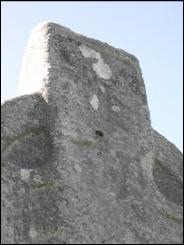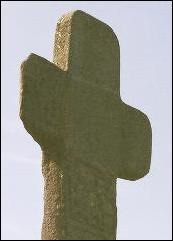The Cross Head: Put simply, where there is a ring, the head of the High Cross consists of the ring, the arms, the top of the shaft and the area within the ring. Where there is not a ring, the same general area of the crossing of the shaft and cross beam is indicated.
The Center: Here the horizontal cross beam and the vertical shaft meet. Many of the figural crosses have a crucifixion scene on the west face of the head of the cross. In the tradition of the early Christian church Christ was crucified looking west. But other scenes and designs appear on the west face and, of course, on the east face as well.
Cross Head: Center
Imediate right: the Cross of Muiredach at Monasterboice (Co. Meath) has a classic depiction of the crucifixion on the west face. Far right: the Kilree Cross (Co. Kilkenny) has a boss surrounded by interlace in the center of the west side. Below right: the North Cross at Castledermot (Co. Kildare) has a depiction of the fall of man with Adam and Eve under the forbidden tree on the west side.
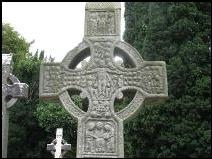
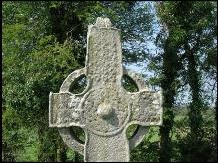
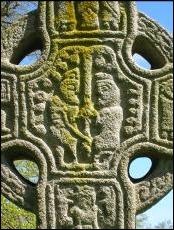
The Ring: There are a number of theories about the origin and meaning of the ring that appears on many of the Irish High Crosses. Theory One finds a pre-Christian, Neolithic or Celtic explanation for the ring. The sun was an important symbol for these early peoples. As Christianity became the primary religion, the ring may have symbolically represented the convergence of the sun with Christ, the son and light of the world. In this case, the ring would be related to wheel, disc and cup-in-circle images from pre-Christian times, which are typically interpreted as sun symbols. (Roe 1995, 213)
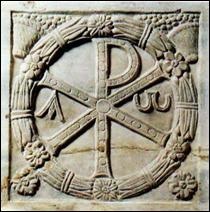
Theory Two finds the origin of the ring in the fourth century CE. The emperor Constantine made use of the Chrismon or Sacred Monogram of Christ (the Chi Rho) encircled by the victor’s wreath as a talisman to ensure military victory. (Roe 1995, 213) It was this symbol rather than the cross that Constantine adopted in 312 CE at the Battle of Milvian Bridge. For Constantine the meaning of this symbol was that Christ provided protection and ensured victory in battle. On the Irish High Crosses this would carry a different but related meaning. Christ is the victor over sin and death and through him Christians share in that victory. To the left is an example of the Chrismon or Labarum.
(Source of image: thefoundationforsacredarts.blogspot.com/ September 2010)
Theory Three suggests that the ring began as diagonal structural supports. These supports would have been on wooden crosses, which almost certainly existed both before and concurrently with the stone crosses. At the very least, an entirely functional explanation of the origin of the circle is unsatisfying. More importantly, Helen Roe (a High Cross scholar) writes, “there seems no single instance in the immense corpus of surviving illustrations of the Cross and of the Crucifixion in which the addition of any brace or strut can be discerned.” (Roe 1995, 214)
Regardless of the origin of the ring, not all rings are the same in appearance. Some have been carved through to clearly reveal the shape of the head of the cross. Others have a solid head with the ring and cross in relief.
Cross Ring
Imediate right: the Ullard High Cross (Co. Kilkenny) has a solid ring. The cross is in relief. The ring is inset with the spaces between the ring and the angles of the cross head more deeply inset. Far right: the Tynan cross (Co. Armagh) is similar to the Ullard cross in that the cross is in relief. Here, however, the spaces between the ring and the angles of the cross head have been carved through. Below right: at Mona Incha (Co. Tipperary), it is difficult to see if the cross arms extended beyond the ring. We also see that the head of the cross is relatively small compared to the massive shaft. Below far right: the Scripture Cross at Clonmacnois (Co. Offaly) shows an elaborately decorated ring with interlace and decorated roundels or volutes extending in from the ring at the center of each perforation.
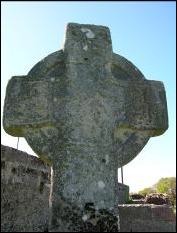
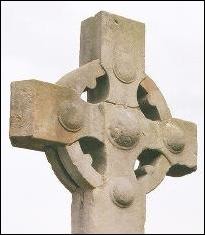
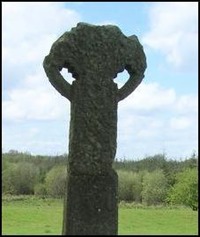
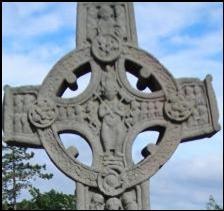
The Arms: The arms of the crosses also vary in general shape and in how far they extend beyond the ring, if there is a ring. For example: the arms of the Scripture Cross at Clonmacnois (above) angle upward just a bit while most are set at right angles to the shaft. In a few rare cases the arms were designed to accept extensions made either of wood or metal.
Cross Arms
Imediate right: the arms of the North Cross at Ahenny (Co. Tipperary) extend beyond the ring and are fully in relief of the ring so that their shape is clear. Far right: the South Cross at Ahenny (Co. Tipperary) offers an illustration of the decoration that typically adorns the ends of the arms. Below right: the Cross of Muirdach at Monasterboice (Co. Meath) illustrates nicely the decoration on the underside of the arm and of the ring. In this case the Hand of God on the lower side of the arm and two intertwined serpents enclosing human heads on the lower side of the ring.

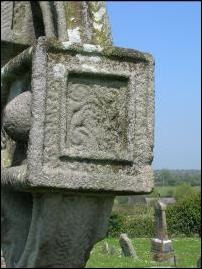
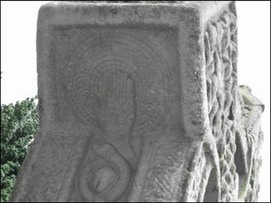
The top of the shaft and the cap: The top of the shaft extends upward beyond the ring. There is often a cap on the top of the cross and, where these occur, they take two primary shapes. (see Richardson and Scarry 25-26) The first shape is domed. This was the shape of the church Constantine had built over the "Holy Seplulchar" in Jerusalem. Thus it was a symbol of the resurrection of Christ. (Richardson and Scarry p. 25) It is worth noting that the dwellings many monks lived in, especially in western Ireland, were also beehive or domed in shape. The symbolism may be the same.
Domed Cross Caps
Imediate right: the cap of the North Cross at Ahenny (Co. Tipperary), left, is circular at its base and beehive or domed in shape. Far right: the cap of the South Cross at Ahenny (Co. Tipperary) is also round at the base but with a much lower dome.
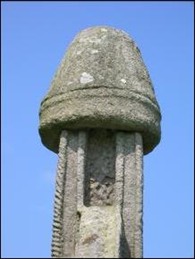
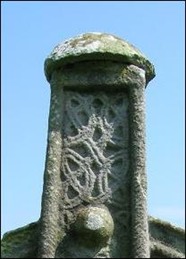
The second style is a gable roof. The two photos below of the cross at Killamery (Co. Kilkenny) show this second style of cap. In some cases an outline of shingles is clearly visible. This style resembles “the picture of Solomon’s temple in the illustration of the temptation of Christ in the Book of Kells (fol. 202v)” (Richardson and Scarry p. 25). It is not surprising that this gable style is also reflected in typical shape of the roof on early Irish chapels and churches. See below.
Gable Cross Caps
Imediately right: the Killamery Cross (Co. Kilkenny) the east side and far right the south sides.
Below and right: two images of a small wooden chapel made of wood. This is located in the museum at Clonmacnois (Co. Offlay). Imediate right: an end view of the chapel looking into the door area. Far right: a side view of the replica of the chapel showing the tiles of the roof. High Cross caps on many crosses follow this model.
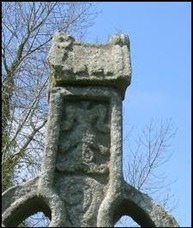

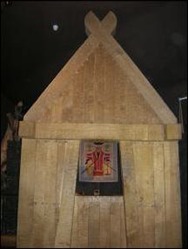
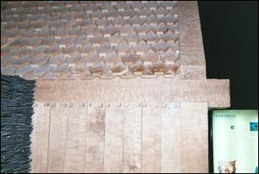
A third style of cross top does not have any cap at all.
Uncaped Crosses
Imediate right: with the Cross at Ullard (Co. Kilkenny) it is difficult to tell whether the upper part of the cross above the ring is part of the shaft or a cap. The tapering from side to side begins immediately above the ring but does not come to a clear roof peak. Far right: the Cross at Clonca (Co. Donegal) clearly does not have a cap.
